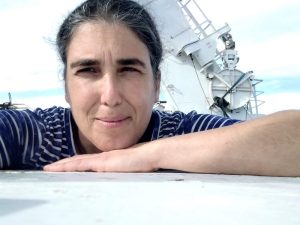
tamar.guy-haim@ocean.org.il
Tel: +972-50-7443233
Senior Researcher
In IOLR since 2018
Research interests:
The Zooplankton Ecology Lab (ZOOPEL) investigates the biology and ecology of aquatic and marine invertebrates, with the goal of understanding the structure, spatial-temporal dynamics, and environmental interactions of diverse ecological communities. Our methods combine classical morphological taxonomy with novel molecular techniques (integrative taxonomy), including DNA barcoding, metabarcoding, and eDNA, as well as optical approaches using artificial intelligence algorithms for classification. We examine the diversity and functions of these species and communities through field observations and experiments. Our research spans a wide range of ecosystems, from shallow coastal seas and deep-sea environments to freshwater systems and caves.
Our ongoing projects include:
Ecosystem effects of gelatinous zooplankton in oligotrophic seas (funded by the Israel Science Foundation). We study the spatio-temporal variability of gelatinous zooplankton in the Israeli Mediterranean Sea and the Gulf of Aqaba, their interactions, and impacts on biodiversity and ecosystem functions under present and predicted conditions.
Cyclonic and anticyclonic eddies as ecological refugia and bioinvasion vector in the Southeastern Mediterranean Sea (funded by the Israeli Ministry of Science and Technology). We characterize the physico-chemical and biological parameters in mesoscale eddies of the Eastern Mediterranean Sea using novel in-situ methodologies, molecular metabarcoding and sea-going campaigns.
Effects of crude-oil and gas-condensate pollution on pelagic food webs at the Israeli Mediterranean Sea (funded by the Israeli Ministry of Energy). We investigate the direct and indirect effects of crude oil and gas condensate and their accumulation in the southeastern Mediterranean food web, from phytoplankton to fish.
Deep-sea colonization and metacommunity connectivity in the Israeli Mediterranean Sea (DEEP-CIMS) (supported by the Mediterranean Research Center in Israel). We study recruitment and colonization processes in deep sea habitats of the Israeli Mediterranean Sea.
eDNALEV: Enhancing biodiversity assessments through eDNA analysis in the Levantine Sea (funded by Israel Ministry of Science and Technology Israel-Cyprus Collaboration). We develop and employ novel methodologies of environmental DNA and metabarcoding for enhancing biodiversity assessments in the Israeli and Cypriot Mediterranean Sea.
Selected publications:
See a full list of publications: https://scholar.google.com/citations?user=EVlMdPsAAAAJ&hl=en
- Iakovleva, A., Morov, A.R., Angel, D., Guy-Haim, T., 2024. From ctenophores to scyphozoans: a parasitic spillover of the burrowing sea anemone Edwardsiella (Cnidaria: Actinaria). Scientific Reports 14, 20785. https://doi.org/10.1038/s41598-024-72168-7
- Velasquez, X., Morov, A.R., Astrahan, P., Tchernov, D., Meron, D., Almeda, R., Rubin-Blum, M., Rahav, E. and Guy-Haim, T., 2024. Bioconcentration and lethal effects of gas-condensate and crude oil on nearshore copepod assemblages. Marine Pollution Bulletin, 203, p.116402. https://doi.org/10.1016/j.marpolbul.2024.116402
- Guy-Haim, T., Kolodny, O., Frumkin, A., Achituv, Y., Velasquez, X. and Morov, A.R., 2023. Shedding light on the Ophel biome: the trans-Tethyan phylogeography of the sulfide shrimp Tethysbaena (Peracarida: Thermosbaenacea) in the Levant. PeerJ, 11, p.e16690. https://doi.org/10.7717/peerj.16690
- Rilov, G., Canning‐Clode, J. and Guy‐Haim, T., 2024. Ecological impacts of invasive ecosystem engineers: A global perspective across terrestrial and aquatic systems. Functional Ecology, 38(1), pp.37-51. https://doi.org/10.1111/1365-2435.14406
- Velasquez, X., Morov, A.R., Belkin, N., Kurt, T.T., Rubin‐Blum, M., Tchernov, D., Meron, D. and Guy‐Haim, T., 2023. Feeding strategy and dietary preference shape the microbiome of epipelagic copepods in a warm nutrient‐impoverished ecosystem. Environmental DNA, 5(1), pp.38-55. https://doi.org/10.1002/edn3.357
- Guy-Haim, T., Velasquez, X., Terbiyik-Kurt, T., Di Capua, I., Grazia Mazzocchi, M. and Morov, A.R., 2022. A new record of the rapidly spreading calanoid copepod Pseudodiaptomus marinus (Sato, 1913) in the Levantine Sea using multi-marker metabarcoding. BioInvasions Record, 11(4). https://doi.org/10.3391/bir.2022.11.4.14
- T. Guy-Haim, E. Rahav, M. Rubin-Blum, J. Silvermann, G. Sisma-Ventura. The effects of decomposing invasive jellyfish on biogeochemical fluxes and microbial dynamics in an ultraoligotrophic sea, 2021. Biogeosciences. https://doi.org/10.5194/bg-17-5489-2020
- O. Peleg, T. Guy-Haim. A 150-year-old idea could impede Suez Canal invasions, 2019. Nature. https://doi.org/10.1038/d41586-019-03476-6
- T. Guy-Haim, R. Mant, D. A. Lyons, F. Bulleri, L. Benedetti-Cecchi, J. Kotta, A. Queirós, E. Chatzinikolaou, T. Crowe, G. Rilov. Diverse effects of invasive ecosystem engineers on marine biodiversity and ecosystem functions – a global review and meta-analysis, 2018. Global Change Biology. https://doi.org/10.1111/gcb.14007
- T. Guy-Haim, O. Hyams-Kaphzan, E. Yeruham, A. Almogi-Lubin, J. T. Carlton, 2017. A novel marine bioinvasion vector: Ichthyochory, live passage through fish. Limnology and Oceanography: Letters. https://doi.org/10.1002/lol2.10039





